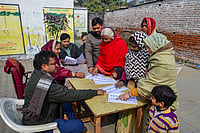The month of April is celebrated as the Dalit History Month. While conversations on the issues facing the community increase during the period, the everyday struggles continue unabated, which include engrained discrimination to institutional apathy.
Just in February, an 18-year-old Dalit student at Indian Institute of Technolog`y, Bombay (IIT Bombay) died by suicide allegedly after suffering caste discrimination on the campus. Incidents like the online trolling of Dalit journalists or targeting of Dalit sportspersons after the defeat of the team reflect the deep-rooted issue of caste-based discrimination.
While the Constitution bans untouchability and bans caste discrimination, it remains a social reality and reports and anecdotes from time to show it.
As we observe the Dalit History Month, here we explore what's caste discrimination and retrace some incidents in recent years that a everyday struggles for Dalits continues despite decades of sociopolitical efforts.
Caste discrimination in India
Caste discrimination refers to the unequal treatment and historical marginalisation and discrimination faced by certain social groups because of belonging to so-called lower castes. In caste system, there is a birth-based hierarchy of social groups called castes. These castes are divided into higher and lower.
Though it's said to be a rural pheononenon at times, caste discrimination also plays out in higher educational campuses and workplaces where students and professionals from these historically discriminated and marginalised communities have at times faced discriminatory and hateful behaviour.
Even after all these years of social progress, Pew Research shows only mixed findings as caste-based segregation and discrimination remain prevalent.
"Caste segregation remains prevalent in India. For example, a substantial share of Brahmins say they would not be willing to accept a person who belongs to a Scheduled Caste as a neighbor. But most Indians do not feel there is a lot of caste discrimination in the country, and two-thirds of those who identify with Scheduled Castes or Tribes say there is not widespread discrimination against their respective groups. This feeling may reflect personal experience: 82 per cent of Indians say they have not personally faced discrimination based on their caste in the year prior to taking the survey," notes a Pew report.
Incidents of Dalits' harassment, abuse
Despite constitutional assurance of equality, incidents often come to light that show that there is still a long road to an equal world.
Here we retrace some incidents where caste-based abuse and violence was most starkly visible, showing that while we might have come a long way in recent decades, there is still long way to go.
1. Darshan Solanki's death
Darshan Solanki, an 18-year-old Dalit student at IIT Bombay, died after allegedly facing caste-based abuse in the campus.
While an internal investigation denied caste angle in the student's death, police later arrested a fellow student and slapped him with SC/ST Act charges. The arrested student was identified as Armaan Iqbal Khatri.
The arrest was made after the police found a suicide note in which the name of the accused student was mentioned.
The Hindu reported, "'Armaan has killed me,' read the note, which was found in Solanki’s hostel room recently, after which police registered a case under Section 306 (abetment of suicide) of the Indian Penal Code and relevant Sections of the Scheduled Caste and Scheduled Tribe (Prevention of Atrocities) Act, 1989. The victim and Armaan had stayed on the same floor of a hostel of the premier institution and were batchmates. According to the investigators, the duo had had a dispute over Mr. Khatri’s alleged comments about a religious community."
Caste in campus has been a well-documented issue has surfaced time and again. It captures national attention when incidents like the suicides of Darshan or Rohith Vemulla take place.
In his book Caste Discrimination and Exclusion in Indian Universities: A Critical Reflection, Dr N Sukumar notes that education is very often the only way of upward social mobility for marginalised students of lower castes and poor treatment at these very mediums of upliftment sets them back.
Sukumar notes, "What is important to note here is that the marginalised students from rural areas are deeply committed to the transformation wrought by higher education. Metropolitan students who don't succeed simply find another job, start a business, or recuperate and start again somewhere else. For these marginalised students, this opportunity [to study] is the only one."
2. Untouchability, caste-based violence
Though untouchability is illegal, incidents appear from time to appaer that show that there exists significant gap between policy and practice.
Last year in Rajasthan, a nine-year-old Dalit boy from Rajasthan’s Jalore district died after he was allegedly beaten by his teacher for drinking from an earthen pot meant for people from the upper castes.
"Discrimination against Dalits is endemic in Indian society, especially with regard to notions of 'impurity' and 'contamination'. Even Dalit children bear the brunt of such discrimination in school, not just from teachers but from upper caste fellow students," noted Kavita Chowdhury in The Diplomat.
Very often, such violence is intersectional as caste and other issues like gender also come together. In Hathras, Uttar Pradesh, A 19-year-old Dalit woman was allegedly gang-raped in a field by four upper-caste men in the morning. She had gone there to collect cattle fodder.
The case captured natioanl attention not only for the brutality of the crime but also for the way the UP government treated it.
The family alleged that the police delayed the registration of the FIR and when the FIR was finally registered against Sandeep for an attempt to murder under sections of the SC/ST Act, according to The Times of India.
After the woman's death, the police cremated her in the night without the presence of her family. This forced cremation was also severely criticised and was seen as a sign of a cover-up.
3. Opposition to caste-ban laws
Seattle recently became the first city in the United States to bring a law to address workplace caste discrimination.
However, a section of the Hindu population criticised the law as unfairly targeting Hindus.
These groups ignore the fact that the law applies to everyone, not just Hindus. The law added caste to the list of social categories that are protected formally from workplace dicrimination. These laws were criticised for being Hinduphobic.
Dalit thinker and author Kancha Ilaiah Shepherd writes, "There have been studies which show how caste discrimination operates among Indian migrants in the US, Canada, Australia, Europe and other Western regions. They narrate the stories of discrimination and the trauma that school- and college-going children and youth undergo on an everyday basis."
"Why does the 'Vishwaguru' try to derail the struggle against discrimination, inequality and xenophobia by invoking the spectre of Hinduphobia? Are they trying to say Hinduism does not stand for human equality?" writes Shephard further in The Wire.
Even as caste discrimination remains an every day reality, and has been taken abroad by migrants from South Asia, the opposition to such laws is a denial to the truama of so many people.
4. SC/ST Act lacks teeth
While the Scheduled Castes and Scheduled Tribes (Prevention of Atrocities) Act, 1989 has been described as a powerful law, and some critics have also said that there are fewer safeguards for the accused and blanket arrests are often made, a study found that the implementation of the law is still very patchy.
Bihar, the state with one of the highest reported crimes against SC/ST, has a conviction rate of only 4.79 per cent, wrote Ankush Pal in an article for Outlook. Citing Dalit Human Rights Defenders Network's findings, he wrotem that only 6.69 per cent of cases were appealed in higher courts. Moreover, courts and state prosecutors assigned such cases are also overburdened despite the rules saying that courts for such cases need to be exclusive.
Pal further noted that complainants often do not get the compensation during the legal proceedings that's mandated in the rules.
He wrote, "According to the Act, the first tranche of payment must be released within seven days. Data reveals that it is done in under 10 per cent of the cases...The RTI responses further reveal that the victims do not receive compensation at the second —after the charge sheet is filed— and the third stages — after conviction. Even travel and maintenance costs are less likely to be provided to victims, their dependents, and eyewitnesses, both of which are mandated by the SC/ST Act to cope with the costs of lengthy trials. In cases where the expenses are received, the amount is abysmally low."
5. Targeted trolling, abuse
After the Indian women's hockey team lost in Olympics, casteist slurs were thrown at team member Vandana Kataria's house in Uttarakhand.
The New Indian Express reported, "Hours after Argentina beat India in the women’s hockey semis at the Tokyo Olympics on Wednesday, two upper caste men in Haridwar stood outside star striker Vandana Katariya’s home at Roshnabad village and started hurling casteist abuses. They started to dance and burst crackers to mock Vandana Katariya’s family. According to Vandana’s family, the miscreants stated that the reason behind India's loss was that it had 'too many Dalit players'."
When journalist Meena Kotwal raised the issue in a tweet, she was also abused with casteist slurs and abuses on Twitter. Screenshot of one such tweet was shared by another journalist.
Later, Kotwal also faced online abuse for burning Manusmriti, an ancient Hindu manuscript that's condemned by anti-caste activists and scholars for providing an unequal status to so-called lower castes and women.
"Kotwal said that while many people have symbolically burnt the Manusmriti, she faced a deluge of casteist and obscene calls and messages from members of right-wing groups, such as the Bajrang Dal and the Vishwa Hindu Parishad—calling her a prostitute, asking her to drink the urine of Brahmins, saying that her number had been shared in many groups so that more people could call her. There was also a video of a man showing his penis and death threats, referring to Gauri Lankesh, the journalist who was shot dead on 5 September 2017 outside her home in Bengaluru, allegedly by Hindu extremists," reported Mooknayak in an article, an organisation Kotwal founded.


























